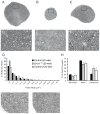Premature aging-related peripheral neuropathy in a mouse model of progeria
- PMID: 21596054
- PMCID: PMC3179831
- DOI: 10.1016/j.mad.2011.04.010
Premature aging-related peripheral neuropathy in a mouse model of progeria
Abstract
Peripheral neuropathy is a common aging-related degenerative disorder that interferes with daily activities and leads to increased risk of falls and injury in the elderly. The etiology of most aging-related peripheral neuropathy is unknown. Inherited defects in several genome maintenance mechanisms cause tissue-specific accelerated aging, including neurodegeneration. We tested the hypothesis that a murine model of XFE progeroid syndrome, caused by reduced expression of ERCC1-XPF DNA repair endonuclease, develops peripheral neuropathy. Nerve conduction studies revealed normal nerve function in young adult (8 week) Ercc1(-/Δ) mice, but significant abnormalities in 20 week-old animals. Morphologic and ultrastructural analysis of the sciatic nerve from mutant mice revealed significant alterations at 20 but not 8 weeks of age. We conclude that Ercc1(-/Δ) mice have accelerated spontaneous peripheral neurodegeneration that mimics aging-related disease. This provides strong evidence that DNA damage can drive peripheral neuropathy and offers a rapid and novel model to test therapies.
Copyright © 2011 Elsevier Ireland Ltd. All rights reserved.
Figures



Similar articles
-
A mouse model of accelerated liver aging caused by a defect in DNA repair.Hepatology. 2012 Feb;55(2):609-21. doi: 10.1002/hep.24713. Hepatology. 2012. PMID: 21953681 Free PMC article.
-
In Vivo Renin Activity Imaging in the Kidney of Progeroid Ercc1 Mutant Mice.Int J Mol Sci. 2021 Nov 18;22(22):12433. doi: 10.3390/ijms222212433. Int J Mol Sci. 2021. PMID: 34830315 Free PMC article.
-
Transcriptional profiling reveals progeroid Ercc1(-/Δ) mice as a model system for glomerular aging.BMC Genomics. 2013 Aug 16;14:559. doi: 10.1186/1471-2164-14-559. BMC Genomics. 2013. PMID: 23947592 Free PMC article.
-
Physiological consequences of defects in ERCC1-XPF DNA repair endonuclease.DNA Repair (Amst). 2011 Jul 15;10(7):781-91. doi: 10.1016/j.dnarep.2011.04.026. Epub 2011 May 25. DNA Repair (Amst). 2011. PMID: 21612988 Free PMC article. Review.
-
Do DNA Double-Strand Breaks Drive Aging?Mol Cell. 2016 Sep 1;63(5):729-38. doi: 10.1016/j.molcel.2016.08.004. Mol Cell. 2016. PMID: 27588601 Free PMC article. Review.
Cited by
-
Mechanistic insights into transcription coupled DNA repair.DNA Repair (Amst). 2017 Aug;56:42-50. doi: 10.1016/j.dnarep.2017.06.006. Epub 2017 Jun 9. DNA Repair (Amst). 2017. PMID: 28629777 Free PMC article. Review.
-
Dental and craniofacial characteristics in a patient with Hutchinson-Gilford progeria syndrome.J Orofac Orthop. 2014 Jul;75(4):251-63. doi: 10.1007/s00056-014-0216-x. Epub 2014 Jul 9. J Orofac Orthop. 2014. PMID: 25001855
-
A retrospective study on side effects of first-line antiretroviral drugs on HIV patients based on 1A, 2A, and 5A regimen records at Zomba Central Hospital, Malawi.Afr Health Sci. 2023 Sep;23(3):468-480. doi: 10.4314/ahs.v23i3.54. Afr Health Sci. 2023. PMID: 38357124 Free PMC article.
-
Loss of DNA repair mechanisms in cardiac myocytes induce dilated cardiomyopathy.Aging Cell. 2023 Apr;22(4):e13782. doi: 10.1111/acel.13782. Epub 2023 Feb 3. Aging Cell. 2023. PMID: 36734200 Free PMC article.
-
ERCC1-deficient cells and mice are hypersensitive to lipid peroxidation.Free Radic Biol Med. 2018 Aug 20;124:79-96. doi: 10.1016/j.freeradbiomed.2018.05.088. Epub 2018 Jun 1. Free Radic Biol Med. 2018. PMID: 29860127 Free PMC article.
References
-
- Abbas A, Yang G, Fakih M. Management of anal cancer in 2010. Part 2: current treatment standards and future directions. Oncology (Williston Park) 24:417–24. - PubMed
-
- Authier N, Gillet JP, Fialip J, Eschalier A, Coudore F. An animal model of nociceptive peripheral neuropathy following repeated cisplatin injections. Exp Neurol. 2003;182:12–20. - PubMed
-
- Bouche P, Cattelin F, Saint-Jean O, Leger JM, Queslati S, Guez D, Moulonguet A, Brault Y, Aquino JP, Simunek P. Clinical and electrophysiological study of the peripheral nervous system in the elderly. J Neurol. 1993;240:263–8. - PubMed
Publication types
MeSH terms
Substances
Grants and funding
- R01 CA119298/CA/NCI NIH HHS/United States
- P30 DK079307/DK/NIDDK NIH HHS/United States
- R01 CA076541/CA/NCI NIH HHS/United States
- CA119298/CA/NCI NIH HHS/United States
- P30AG024827/AG/NIA NIH HHS/United States
- AR051456/AR/NIAMS NIH HHS/United States
- R21 AG033907/AG/NIA NIH HHS/United States
- AG024827/AG/NIA NIH HHS/United States
- DK04493/DK/NIDDK NIH HHS/United States
- P30 AG024827/AG/NIA NIH HHS/United States
- P30DK079307/DK/NIDDK NIH HHS/United States
- ES016114/ES/NIEHS NIH HHS/United States
- U01 NS058451/NS/NINDS NIH HHS/United States
- CA076541/CA/NCI NIH HHS/United States
- AG033907/AG/NIA NIH HHS/United States
- NS058451/NS/NINDS NIH HHS/United States
- P01 DK044935/DK/NIDDK NIH HHS/United States
- R01 ES016114/ES/NIEHS NIH HHS/United States
LinkOut - more resources
Full Text Sources
Medical
Molecular Biology Databases

